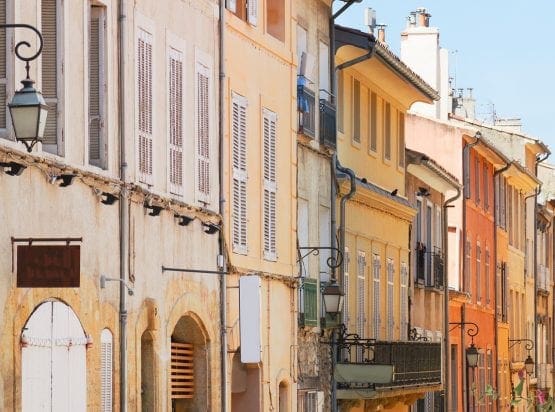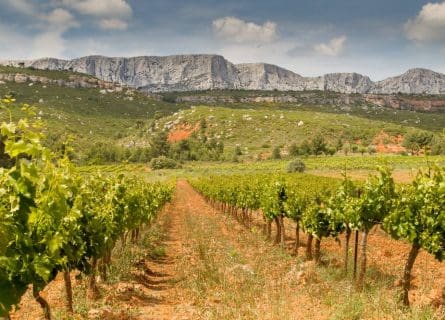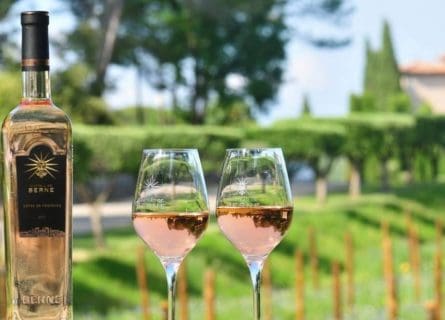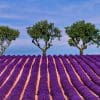Uncover Aix-en-Provence's vibrant flavors and culinary gems with our expert guides. Plan an unforgettable trip now!
Read more
EXPLORE ALL OUR PROVENCE WINE REGIONS GUIDE
Last updated: April 4, 2025
The landscape of Coteaux d’Aix-en-Provence has been enchanting tourists for centuries. Its chic capital, Aix-en-Provence, offers a surfeit of hedonistic and cultural attractions. But most importantly, this elegant destination serves as the perfect springboard for exploring the sizable Coteaux d’Aix-en-Provence appellation.
It is Provence’s second biggest wine zone, situated in the wider region’s western section. As elsewhere, winegrowers make a great deal of light and aromatic rosé here, although Coteaux d’Aix-en-Provence is far from being a one-trick pony.
On the contrary, the region has a burgeoning self-confidence that is infectious, driven by greater levels of investment and winemaker innovation.
Indeed, Coteaux d’Aix-en-Provence actively encourages experimentation with different varieties/blends and vinification techniques; in contrast, conservatism and tradition tend to dominate in regions like Burgundy and Champagne, for example, where regulations tightly control the grape varieties used in blends. Yet, in Provence, self-expression is considered sacrosanct. Welcome to France’s most avant-garde vineyard.
Discover More About French Wine

Like many of Provence’s winemaking villages and communes, the contemporary industry owes its origins to ancient explorers – the Greeks (who arrived in 600 BC), then the Romans, and subsequently a whole host of Mediterranean powers who wished to claim Provence as their own.
Established as common practice by the itinerant Greeks, viticulture thrived in Roman Gaul (France) after Julius Caesar’s armies conquered great western European swathes in the last century BC.
And what a vast prize they had won: Provincia Romana stretched from the southern reaches of the Alps to the mighty Rhone River. It was a rich and fertile land that became synonymous with vines, olive trees, and endless fields of lavender.
However, even the powerful Romans could not maintain their hegemonic grip over Europe forever. In the 5th century, attacks from rival civilizations – combined with internal hubris and decadence – weakened the empire to the point of collapse. This finally occurred in AD 476, and all hell broke loose!
A succession of invaders (including the long-haired Visigoths, Vandals, and Ostrogoths) attempted to subjugate the region before the superior Frankish armies kicked them out. This Germanic civilization rose to power during the beginning of the Dark Ages and remained a powerful influence in European affairs for over six centuries.
Their successor, the Carolingians, overthrew the Franks with the support of the Papacy. This dynasty’s greatest moment saw emperor Charlemagne unite western and central European territories, laying the foundations for the Holy Roman Empire.
The Papal Influence
Meanwhile, Provence had caught the attention of the Catholic Church. In the 1300s, turbulence in Rome led to a mass relocation of the Papacy from Italy to southern France. Establishing a base in Avignon, successive popes encouraged the spread of viticulture across the region, while Provencal art and literature entered a golden age in the 12th century.
Yet a recently unified French state would not tolerate an interloper in its midst; the Papacy lost control of Provence in the 15th century, albeit Avignon and Carpentras kept their independence until the late 1700s.
Resurgence as a Premier Viticultural Region
By the time of the Second Empire, Europe recognized Provence as France’s premier source of rosé. However, the phylloxera louse did not spare Provence’s vineyards when it reached Europe in the late 19th century.
Replanting vines on (disease-resistant) American rootstocks saved France’s wine industry from annihilation, and Provence subsequently began to recover in the early 1900s. Today, Coteaux d’Aix-en-Provence continues to win recognition for its superlative rosés and a rising number of exceptional red and white wines.

Basking in a dreamy Mediterranean climate, vines in Coteaux d’Aix-en-Provence receive a lot of care. On average, the region’s vineyards enjoy over 3,000 sunshine hours per year and long, dry, leisurely summer days; growers in the appellation are rarely concerned with rain during harvest. Grapevine diseases that often provide major headaches in Champagne – and the Loire – are largely absent.
You’ll find this serene paradise in the western sector of Provence; vineyards spread out in a north, south, and westerly direction from Aix-en-Provence. The largest swathe is to the northwest of the town, with the village of Senas marking the end of the designation’s boundaries.
Vineyards are located along the Durance River, which winds its way towards the Mediterranean and on the lower slopes of the Sainte-Victoire mountain range; they also surround the lagoon ‘Etang de Berre.’
Challenges of Excellence
Yet, producing mediocre wine in this slice of Eden would be all too easy. Indeed, the challenge for Coteaux d’Aix-en-Provence and the entire region is avoiding overripeness and making blowsy wines. With little effort, growers can make drinkable but utterly anonymous bottles of alcoholic plonk. Fortunately, the appellation boasts superior terroir and a plethora of high-altitude climats (vineyard sites).
In Coteaux d’Aix-en-Provence, vineyards in the Var department, which enjoys a cooler microclimate, qualify for ‘grand cru’ status.
Meanwhile, the Saint-Victoire mountain range helps moderate the summer heat, aided by the all-important Mistral wind, which frequently crops up in discussions about local terroir. The winds emanating from the north are an essential aspect of the appellation quality factor, helping to smooth out the harshest edges of growing-season temperatures, which can reach over 40 degrees Fahrenheit.
Soil Diversity and Its Impact
This brings us nicely to the subject of soil variation. When rainfall is not freely distributed, vines rely on the soil’s water retention capabilities, ideally served by the abundance of clay/limestone across the appellation.
A calcareous terroir is ideal for both red and white varieties in a Mediterranean climate and offers both a porous and permeable subsoil. Growers cultivate on more sandy soils in other parts of the zone, while loamy soils containing a mix of clay, sand, and silt particles are typically found on the elevated terraces of the Arc and the Durance River.
These fertile soils can lead to excessive yields if the plant’s vigor is not strictly controlled. Overall, though, Coteaux d’Aix-en-Provence is blessed with terrain conducive to producing high-quality wines.

Coteaux d’Aix-en-Provence is a region of family concerns and cooperatives, with relatively few poor or lazy producers. It is also a fairly young designation, created in 1985. Today, winemakers continue to draw on a diverse palette of grape varieties, producing everything from aromatic rosé to potent and fiery Grenache-dominant blends.
Dominance of Rosé
Nevertheless, rosé constitutes over 80% of the region’s total production, while reds increasingly account for over 12%. There is a strong culture of blending in the zone: both red and pale-colored rosé wines are typically concoctions of indigenous varieties, most often Grenache, Carignan, Cinsault, and Mourvedre.
White wines also tend to be multi-grape blends, utilizing Vermentino, Grenache Blanc, Sauvignon Blanc, Ugni Blanc, Clairette, Bourboulenc, and Semillion. As you would expect, attitudes to winemaking and aging can vary significantly.
Winemaking Techniques
One producer will ferment their wines in ancient oak vats and concrete tanks – hipsters love experimenting with vinification in amphora and long periods of skin contact. But, as a general rule, white and rosé styles are subject to protective handling and fermentation at low temperatures in stainless steel. This yields a very aromatic and racy style, with plenty of exotic fruit on the mid-palate. Such wines are highly fashionable, and therefore, this dictates, to a certain extent, winemaking philosophies in the appellation.
Diversity of Terroir
However, much will also depend on the vineyard’s location: a Grenache/Syrah blend produced from grapes grown on sandy soils will be a world apart from a similar wine that utilizes vineyards on higher ground, planted on calcareous soils. In any case, there is a minefield of quality for the wine enthusiast to explore. The most exciting wines tend to be made by passionate individuals, often first- or second-generation wine producers who would, in another age, have pursued easier professions. But Coteaux d’Aix-en-Provence continues to draw in raw talent from across Europe, justifying its reputation as one of Provence’s most dynamic and exciting appellations.
Coteaux d’Aix-en-Provence is far more diverse than it is given credit for. The local cliché, of course, is sun-kissed rosé: bright and delicate wines enjoyed year-round by a very appreciative audience. Yet the region also markets a growing volume of excellent red and white wine – intriguingly perfumed and delightfully complex.
This is essential: rosé is Provence’s flagship, but it can be somewhat predictable, and there is a wealth of competition in the South of France. The old adage about “not putting all your eggs in one basket” is particularly relevant today.
Indigenous Counoise Grape
But what are your options if you’ve begun to tire of Provencal pink? The indigenous Counoise grape is one example of how the appellation broadens its horizons. This dark-skinned variety yields a very spicy and concentrated red, with garrigue, black cherry, and white pepper aromas.
A touch of barrel maturation – say, five to ten percent – adds texture and richness to this local gem. It should prove a hit with sommeliers and consumers searching for esoteric grapes and authentic flavors.
The Rise of White Blends
White blends are another highlight, particularly concoctions of Marsanne and Grenache Blanc. Again, just the right amount of oak will transform a pleasant drop into something far more structured and refined, with the capacity to improve in bottle.
Indeed, Grenache Blanc is attracting more attention as growers in Coteaux d’Aix-en-Provence expand and deepen their knowledge of premium white wine production. In the 1900s, most considered it an unremarkable variety, but it could be the appellation’s secret weapon; old vines yield delicious aromatic wines that defy expectations.
A Sustainable Future Through Diversity
Modern Coteaux d’Aix-en-Provence is redefining itself as a region of many colors, helping to create a more sustainable future for its wine-growing community. The world does not need any more quaffable rosé, especially at the lower end of the price spectrum, but the market for high-quality whites is growing constantly.
Bourboulenc is a white wine grape variety grown mainly in Southern Rhône, Provence, and Languedoc in southern France.
Find out moreSavor Clairette blanche, a captivating white wine grape from France's Chateauneuf-du-Pape, Provence, Rhône, and Languedoc vineyards
Find out moreGrenache blanc is a white wine grape varietal popular in the Rhône, Châteauneuf-du-Pape and Languedoc-Roussillon regions of Southern France.
Find out moreUncover the allure of Marsanne grape variety. From its traditional role in Rhône blends to the new wave of single-varietal Marsanne wines.
Find out morePascal Blanc is a rare, disease-sensitive white grape used in Cassis AOC wines, where it can make up to 40% of the blend. It thrives in Cassis' warm, dry climate and adds citrus, herb, and nutty flavors to the region's light, dry wines.
The sauvignon blanc grape varietal, originally from the Bordeaux region of France, is now one of the world's most loved white varieties.
Find out moreTerret Blanc is an old, high-yielding grape variety from southern France, once popular for Vermouth and dry whites. Its use has declined, but it's still permitted in certain French AOCs, contributing 10-30% to white wine blends. The grape produces light, crisp wines and is mostly confined to southern France.
Experience Trebbiano Toscano's Renaissance: Aromatic & Fresh Bianco Toscana IGT from Petrolo. The Future of Italian White Wine
Find out moreCarignan is a red grape variety that grows mostly in Southern France, and is often used as a blending grape
Find out moreCinsault is a red wine grape that is important in the Languedoc-Roussillon wine region of France because of its tolerance to high temperatures.
Find out moreDiscover grenache, a mediterranean grape that is dark-skinned red wine grape variety and an unlikely hero of a grape
Find out moreMourvèdre is a red wine grape variety of mysterious origin that's grown around the world, including the Rhone and Provence regions of France.
Find out moreSyrah is dark-skinned and perhaps the most underrated of the 'noble' red grape varieties.
Find out moreThe Romans bequeathed Provence a rich food culture that relies heavily on its signature exports: olives, garlic, fresh herbs, and wine. Indeed, many dishes are prepared with generous amounts of olive oil and ail, not least the bouillabaisse. This delicious chowder will contain at least three kinds of saltwater fish, prepared in a sumptuous stock of onions (but of course!), tomatoes, saffron, and herbs.
The best – and most authentic – place to sample this local delicacy is in Marseille, although there are restaurants in Aix-en-Provence that do a very respectable facsimile.
Provence Gastronomy Guide: Read more

Uncover Aix-en-Provence's vibrant flavors and culinary gems with our expert guides. Plan an unforgettable trip now!
Read more
Uncover Antibes' vibrant flavors and culinary gems with our expert guides. Plan an unforgettable trip now!
Read more
Uncover Avignon's vibrant flavors and culinary gems with our expert guides. Plan an unforgettable trip now!
Read more
Uncover NIce's vibrant flavors and culinary gems with our expert guides. Plan an unforgettable trip now!
Read more
Uncover Marseille's vibrant flavors and culinary gems with our expert guides. Plan an unforgettable trip now!
Read more
Uncover Orange's vibrant flavors and culinary gems with our expert guides. Plan an unforgettable trip now!
Read more
Uncover Saint-Rémy-de-Provence's vibrant flavors and culinary gems with our expert guides. Plan an unforgettable trip now!
Read moreIf you would like us to customize an exclusive luxury tour, contact us and let us know your travel plans. We offer luxury food and wine tours for private groups of a mininium two guests. In addition, all of our private, chauffeured tours are available year-round upon request.

